

Physicochemical and spectroscopic characterization of biofield energytreated panisidine paco 1000102. Physicochemical and Spectroscopic Characterization of Biofield Energy Treated p-Anisidine. Open Access Research Article Pharmaceutical Analytical Chemistry: Open Access Trivedi et al., Pharm Anal Chem Open Access 2015, 1:1 Volume 1 • Issue 1 • 1000102 Pharm Anal Chem Open Access ISSN: PACO, an open access journal Abstract The p-anisidine is widely used as chemical intermediate in the production of various dyes, pigments, and.
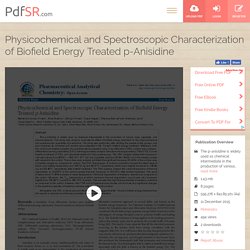
"Physicochemical and Spectroscopic Characterization of Biofield Energy " by Mahendra Trivedi. Mahendra Trivedi, Trivedi Global Inc.
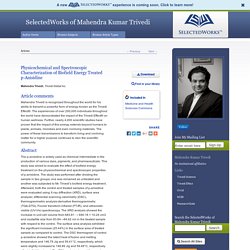
Article comments Mahendra Trivedi is recognized throughout the world for his ability to transmit a powerful form of energy known as the Trivedi Effect®. The experiences of over 200,000 individuals throughout the world have demonstrated the impact of the Trivedi Effect® on human wellness. Further, nearly 4,000 scientific studies have proven that the impact of this energy extends beyond humans to plants, animals, microbes and even nonliving materials. The power of these transmissions to transform living and nonliving matter for a higher purpose continues to stun the scientific community.
Abstract The p-anisidine is widely used as chemical intermediate in the production of various dyes, pigments, and pharmaceuticals. Suggested Citation. Physicochemical and Spectroscopic Characterization of Biofield Energy Treated p-Anisidine. The p-anisidine is widely used as chemical intermediate in the production of various dyes, pigments, and pharmaceuticals.
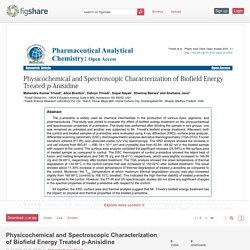
This study was aimed to evaluate the effect of biofield energy treatment on the physicochemical and spectroscopic properties of p-anisidine. The study was performed after dividing the sample in two groups; one was remained as untreated and another was subjected to Mr. Trivedi’s biofield energy treatment. Afterward, both the control and treated samples of p-anisidine were evaluated using X-ray diffraction (XRD), surface area analyzer, differential scanning calorimetry (DSC), thermogravimetric analysis-derivative thermogravimetry (TGA-DTG), Fourier transform infrared (FT-IR), and ultraviolet-visible (UV-Vis) spectroscopy. The XRD analysis showed the increase in unit cell volume from 683.81 → 690.18 × 10-24 cm3 and crystallite size from 83.84→84.62 nm in the treated sample with respect to the control.
Google Scholar Citations. Physicochemical and Spectroscopic Characterization of Biofield Energy Treated p-Anisidine. Bacterial identification using 16s rdna gene sequencing andantibiogram analysis on biofield treated pseudomonas fluorescens cmbo 1000101. "Bacterial Identification Using 16S rDNA Gene Sequencing and Antibiogra" by Mahendra Trivedi. Mahendra Trivedi, Trivedi Global Inc.

Article comments Mahendra Trivedi is recognized throughout the world for his ability to transmit a powerful form of energy known as the Trivedi Effect®. The experiences of over 200,000 individuals throughout the world have demonstrated the impact of the Trivedi Effect® on human wellness. Further, nearly 4,000 scientific studies have proven that the impact of this energy extends beyond humans to plants, animals, microbes and even nonliving materials. The power of these transmissions to transform living and nonliving matter for a higher purpose continues to stun the scientific community. Abstract Biofield therapies have been reported to improve the quality of life as compared to other energy medicine. Suggested Citation. Bacterial Identification Using 16S rDNA Gene Sequencing and Antibiogram Analysis on Biofield Treated Pseudomonas fluorescens. Enterobacter aerogenes (E. aerogenes) has been commonly described as a versatile opportunistic pathogen in hospital infections.
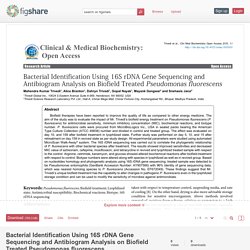
The aim of the present work was to evaluate the impact of biofield treatment on E. aerogenes for its phenotypic and genotypic characteristics. E. aerogenes bearing ATCC 13048 (American Type Culture Collection) was procured from Bangalore Genei, in sealed pack and divided into control and treated groups. Treated group was subjected to Mr. Trivedifs biofield treatment and analyzed for antimicrobial susceptibility, minimum inhibitory concentration (MIC), biochemical reactions, and biotype using automated MicroScan Walk-AwayR system. In addition, treated group of E. aerogenes was evaluated for DNA polymorphism by Random Amplified Polymorphic DNA (RAPD) and 16S rDNA sequencing to establish the phylogenetic relationship of E. aerogenes with different closely related bacterial species. Bacterial Identification Using 16S rDNA Gene Sequencing and Antibiogram Analysis on Biofield Treated Pseudomonas fluorescens. Google Scholar Citations.
Bacterial Identification Using 16S rDNA Gene Sequencing and Antibiogram Analysis on Biofield Treated Pseudomonas fluorescens. Bacterial Identification Using 16S rDNA Gene Sequencing and Antibiogram Analysis on Biofield Treated Pseudomonas fluorescens. You are using an outdated version of Firefox which is not supported by ResearchGate anymore.
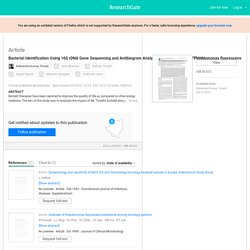
For a faster, safer browsing experience, upgrade your browser now. <div class="c-box-warning full-width-element" style="text-align: center; "><div style="margin: auto; padding:10px;" class="container"><b>For full functionality of ResearchGate it is necessary to enable JavaScript. Here are the <a href=" rel="nofollow" target="_blank"> instructions how to enable JavaScript in your web browser</a>.
</b></div></div>